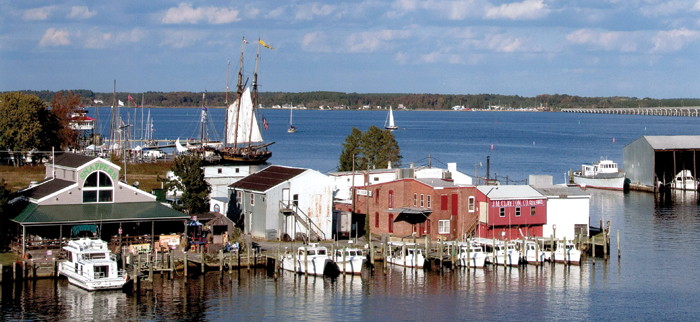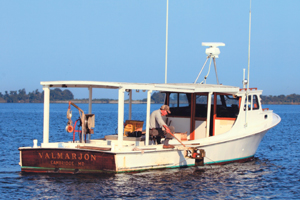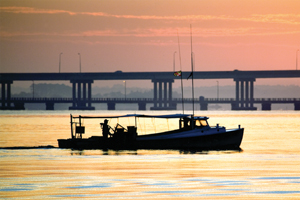Working Waterfronts: Preservation requires balanced, inclusive approaches

Cambridge Creek; by Graham Slaughter
The sun rose high above the Choptank River, a typical day on Maryland’s Eastern Shore. Watermen were already afloat when the City of Cambridge opened the doors to its festival hall at Sailwinds Park. More than 100 individuals representing boaters, watermen, businesses, concerned citizens, non-profit organizations, academics, local planners, and state and federal partners made their way towards the Working Waterfronts Exchange.
What are working waterfronts? The answer depends on who you ask. Generally, they include the lands, infrastructures (i.e. ports, boat harbors, docks, etc.) and waterways that support water-dependent activities, ranging from fishing and seafood processing to recreational boating and boat building, and may have commercial, recreational or cultural ties.
An industry in transition
The Cambridge community once boasted a bustling port overflowing with trade, shipbuilding, commercial fishing and large manufacturing industries. During the 1870s, this small colonial town earned the nickname Queen City due to its growing prosperity and pivotal role in Dorchester County’s marketing and marine trades. The city actively used its deep-water port, which is the second largest in the state after Baltimore.
Today, the city sits at a crossroads. Should Cambridge support recreational interests or commercial ventures? Can residential and industrial coexist?
“The working waterfronts are slowly disappearing,” says Tom Howell, a shipbuilder at Richardson’s Boatyard. “There still are two boatyards on the creek, but there used to be four. They’re slowly going away.”
Jack Brooks of J.M. Clayton Company Seafood has also witnessed the change. “There used to be a dozen seafood processing facilities here,” he explains. “We’re the only one left on the Cambridge Creek.”
This situation is not unique among coastal communities. Much of Maryland’s shoreline was utilized for trade, boat building, fishing, transportation and other marine businesses, where watermen offloaded and processed their hauls. Today the area hosts more residential and recreational uses, which tend to conflict with traditional enterprises.

Waterman; by Chucl Prahl
Maryland takes action
The state’s commitment to preserving these communities began in 2007, when the General Assembly established a Working Waterfront Commission. At the time, development was on the rise and the commission was primarily concerned with ensuring public access. Recognizing a crucial asset for the commercial fishing industry as well, state agency representatives, elected officials, resource-based industry and development entities, and local watermen came together to work towards a solution.
Like many coastal states, Maryland had experienced a decline in historic working waterfront infrastructure and activities, due in part to increasing coastal populations, declining profitability of commercial fishing, rising real estate values and other factors. In 2008, the commission released five recommendations to spur discussion and debate: tax abatement; infrastructure preservation and development; local planning and zoning assistance; education, research, and outreach; and federal legislation.
From there, the Maryland Department of Natural Resources Chesapeake and Coastal Service undertook a Working Waterfronts Initiative to follow up on the recommendations.
Establishing programs that work
The Chesapeake and Coastal Service recognized the strong linkages between Maryland’s natural resources, economy, history, identity and working waterfronts, and established a state advisory committee to highlight the needs of the commercial fishing and marine trade communities.
In partnership with the Virginia Institute of Marine Science, “We collected an inventory to better understand the existing waterfront infrastructure conditions,” explains Kelly Collins, natural resources coastal planner. “With the inventory in hand, we can work with communities to identify current trends and future needs.”
The department is actively working to investigate the socio-economic impacts and define financing and policy strategies with one goal in mind: to create sustainable programs to support unique, local, water-dependent communities.
To help establish such programs, the Chesapeake and Coastal Service partnered with the University of Maryland Environmental Finance Center to evaluate policy and available fiscal resources, and develop a sustainable framework to support working waterfronts.
“The City of Cambridge was an ideal candidate to apply this framework, as it has a long history of maritime culture and is in the process of transformation,” says research associate Brent McCloskey.
Throughout this project, the scope quickly expanded beyond preservation to include broader enhancement and planning goals. “We are still trying to create new industries as well as protect the old ones,” explains Jane Devlin, executive director of the Richardson Maritime Museum.
Susan Zellers of Maryland’s Marine Trades Association and the State Working Waterfronts Advisory Committee agrees these programs cannot solely focus on preservation. “In Maryland the working waterfront has evolved,” she elaborates. “It’s a lot about boating and other recreational uses.”
These observations emphasize that past, present and future uses will differ among the many Chesapeake Bay communities. The challenge is in determining how these activities fit together.

On the Choptank; by Chuck Prahl
The Cambridge exchange
Following a six-month stakeholder engagement exercise with the City of Cambridge, the Environmental Finance Center developed a Framework for Building a Sustainable Working Waterfronts Program, which includes the following six-step process: define the state of the waterfront; identify opportunities; identify barriers; conduct a feasibility assessment; identify resources; develop a business plan.
This process served as the focal point for the Working Waterfronts Exchange held this past June, where stakeholders from across the state shared information on planning, community visioning, economic development, the seafood industry, cultural and heritage tourism, and public needs and obstacles.
Also at the Exchange, the Department of Natural Resources announced a newly established Working Waterfronts Program—a source of technical and financial support including a statewide advisory committee and a grant program. This fall, the department plans to solicit proposals from local governments to support revitalization throughout Maryland through the program. Collins explains, “We hope these enhancement grants will provide the necessary support to tackle longstanding waterfront issues such as public access and competing uses.”
Funding will support comprehensive planning, community scoping, and other activities that result in the integration of working waterfront considerations into a community’s day-to-day decision making.
As the first partner, Cambridge is using the process to integrate their current plan with the prospect of future tourism. Partners are trying to connect the city’s working waterfront with a budding downtown. The recent stakeholder engagement exercise has resurfaced interest in building a marine trade school, using abandoned seafood packing warehouses for the boating trade and exploring uses of the deep-water port.
Says Cambridge business owner J.T. Merryweather, “It’s going to take a lot of motivated people and perseverance, but there is a lot of opportunity here.”
Article by Nicole Carlozo—Chesapeake and Coastal Service coastal and marine assessment natural resource planner.
Appears in Vol. 18, No. 4 of the Maryland Natural Resource magazine, fall 2015.


 1-888-373-7888
1-888-373-7888 233733
233733